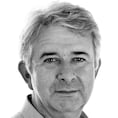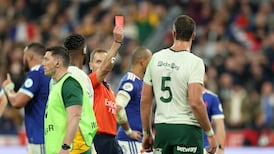After the 2010 autumn international between Ireland and South Africa two Springboks players tested positive for the banned stimulant MHA. Ultimately, it was traced to a supplement given to all the Springboks players in the matchday warm-up, but Bjorn Basson and Chiliboy Ralepelle happened to be the players chosen randomly for doping control after the game.
Basson and Ralepelle were sent home from the tour and provisionally banned. At the disciplinary hearing months later there was a crossfire of blame, and though the players were reprimanded, they escaped suspension. In their judgment, however, the disciplinary panel took a sideswipe at the South African Rugby Union (SARU), essentially accusing them of deflection.
“We disagree with the submission of SARU that the players were at fault and that they should have refused to make use of the supplement. The management of SARU knew that the medical team of the Springbok team supplied the players with supplements. SARU, one assumes, in fact paid for the supplements. If there is any blame to be apportioned in this matter, SARU should be blamed for not having the supplements tested more comprehensively – as required by their own guidelines.”
Afterwards, Ralepelle spoke on behalf of both players, celebrating their innocence.
READ MORE
“Finally, the facts are out there, and people can see that we were not guilty and are not doping cheats,” he said. “We were only doing what the large majority of professional rugby players around the world do by taking a supplement.”
In Ralepelle’s case, though, his innocence didn’t last. In 2014, when he was a Toulouse player, he failed an out-of-competition test while he was recovering from an injury and was suspended for two years.
Astonishingly, five years later, Ralepelle was caught again and banned for eight years, following six months of hearings. At 33, his career was finished.

Ralepelle won the last of his 22 international caps in 2018, but his story folded neatly into the lurid narrative that South African rugby was plagued by a doping culture. In 2019, when Ralepelle was caught for the last time, the Springbok wing Aphiwe Dyanti tested positive, in his case for a cocktail of three banned substances.
Dyanti, who had been World Rugby’s breakthrough player of the year in 2018, had been tested at a Springbok training camp, two months before the World Cup.
Two players who were in that World Cup-winning squad, Sibusiso Nkosi and Elton Jantjies, have since been found guilty of doping infractions; Jantjies received a four-year suspension in January of last year and Nkosi was banned for three years a few months later.
In the chain of South African dopers, they were linked to Johan Ackermann in the late 1990s, and Gerbrandt Grobler and Salmon van Huyssteen and Hendre Stassen and others whose names had no currency outside of South Africa. There was no kink in the narrative.
But how could it be so unambiguous? Nobody believes that doping in rugby is concentrated in one place and yet no other Test-playing nation has a rap sheet as long as the Springboks. Is that because doping is a bigger issue in South Africa than anywhere else, or is it because their testing regime is more targeted and determined?
“From the point of view of the players and staff, I’m sure it’s frustrating when it comes up and everyone wants to behave like it’s just a South African problem, as though the rest of the world hasn’t discovered doping,” says Ross Tucker, a South African-based sports scientist and a research consultant for World Rugby. “But at the same time, you don’t want to play a game of whataboutery. ‘What about them?’
“I’ve got no doubt that every international team and professional team has players who dabbled with or are doping. It’s impossible not to think that. Why would it be about one country? When you see a positive test – and I think this is a really important point – do you say, ‘Look at that, it’s a problem’. Or do you say, ‘Anti-doping is working’.

“If there is a frustration in South Africa it is that most people are saying, ‘Ah look, a doper gets caught in South Africa, clearly there’s a problem’. The other person is saying, ‘Hang on a moment, we’re actually catching ours’.”
Fourteen years ago, the South African Institute for Drug-Free Sport (SAIDS) decided that they needed to chase the problem to its roots. The suggestion that doping was an issue at schools level was only anecdotal until they started testing. There was no precedent anywhere in the world for such an intervention, but they were prepared to be first.
“It wasn’t responsible for us to say, you know, it’s out of our jurisdiction,” says Khalid Galant, the chief executive of SAIDS. “We started speaking with the education authorities and we also wrote to Wada [World Anti-Doping Agency] and got a special waiver in terms of testing at school level and to test with a wide scope – like, say, the Springboks would be tested. It would be the normal doping controls, but the schools would handle the disciplinary process.”
Their first focus was Craven, an annual, weeklong schoolboy tournament that is broadcast live on national TV. For the boys taking part, it is seen as an audition for the professional game. Scouts from all over South Africa and farther afield come to watch the talent parade.
At the 2011 tournament SAIDS turned up four positive results, despite an aggressive education campaign in schools over the previous few months. Over the following dozen years that pattern continued. In 2014 there were three positive tests, in 2015 there were five, four in 2016, three in 2017, six a year later, five in 2022, three in 2023.
All of these were teenagers. In some cases, said Galant, parents and coaches were complicit.
The father of one boy who had been banned for two years testified at one hearing that drug-taking was widespread at his school in the Limpopo region. “If one tested out of season one would be shocked as this was happening from under-14 level,” said the boy’s father, who was a church minister. “There were a whole lot of pills being taken. At the Craven week it seemed that the South Africa schools players who had used steroids knew when to stop.”
The depth of the problem was anyone’s guess. In 2015, the Natal Sharks established a community education programme under the leadership of their club doctor Glen Hagemann. He conducted an anonymous survey of 23,000 boys from 23 high schools in KwaZulu-Natal and the results were staggering.
Boys as young as 13 said they had used steroids. Of the school-leavers, aged 18-19, 10 per cent had used steroids at some stage of their school lives, even though two-thirds of them had done so for reasons of body image; the remainder were motivated by rugby.
“There’s two schools of thought on this,” says Tucker. “One is if you’re doping at that age, why would you stop? You just keep going. It’s cultural. You’re doping as a teenager and as the sport becomes more competitive and you get older the incentive to dope gets higher because now there are professional contracts on the line.
“The other argument is that as a professional the stringency of testing increases, so the prevalence of doping must go down. Like most things in anti-doping, what you think probably reveals what you thought to begin with.”
In the schools SAIDS were not satisfied with identifying offenders, they went after the pushers. “We investigate beyond the positive,” says Galant. “We interview the kid and try to find the source in terms of the supply chain. The law is much easier to prosecute people trafficking steroids to school kids and school premises.
“When we do these raids, especially with a link to school-going age, it is not only steroids that are found but also other drugs that are popular with teenagers. We often find Ritalin, which is a prescription-only medication for attention deficit disorder but is often abused by teenagers. We often pick up other street-level pharmaceuticals too.
“A few months ago, there were three raids [on suppliers] carried out by law enforcement, and they were prosecuted to the full extent of the law. One of the raids was from intelligence information we got from a young athlete – in this case, it was a rugby player.”
In every country the local anti-doping agencies conduct risk profiles on the sports in their jurisdiction. Nobody has enough resources to make a blanket attack on drug taking so they make judgments based on motive and opportunity. In South Africa, according to Galant, rugby players are tested more than any other athletes.
“Rugby is such a high-profile sport in South Africa that the pay-off is really high,” says Galant. “So, people are prepared to take short cuts [with doping], roll the dice and take a risk.”
In the history of doping in sport, the testers have never been in front. Like all the other professional sports, rugby has no idea how widespread doping is at elite level. Outside of South Africa, how many tier-one rugby nations have a sense of how endemic doping is at schools level. How many are prepared to ask the question. Does the IRFU know? Currently there is no testing in Irish schools.
“If World Rugby is testing it’s only in a very specific, obvious window,” says Tucker. “Anti-doping relies on federations to test when teams are not playing matches. It has to be very much a collective effort for federations to look after their own dope testing. But then you get the problem of, ‘Do they really want to catch their own people?’ That’s the doping dilemma.”
[ Sport Ireland carried out 2,029 anti-doping tests in 2024 at a cost of almost €3mOpens in new window ]
Asenathi Ntlabakanye is the latest South African player to fall under a doping cloud. Traces of what is referred to as a “specified drug” were found in his system, which, typically, would lead to a warning rather than a suspension.
However, in the doping control process, Ntlabakanye listed the medication he was taking, and it included a drug that contained DHEA – a “non-specified, performance enhancing” substance – which hadn’t shown up in his sample. Unusually, SAIDS did not provisionally suspend him pending a hearing, which, according to Craig Ray of the Daily Maverick newspaper in South Africa, “suggests they believe it was an honest mistake stemming from poor medical advice”.
A couple of weeks ago Ntlabakanye was called into the Springboks’ touring party as injury cover. Did they care how that might look? South Africa lost control of the optics a long time ago.





















